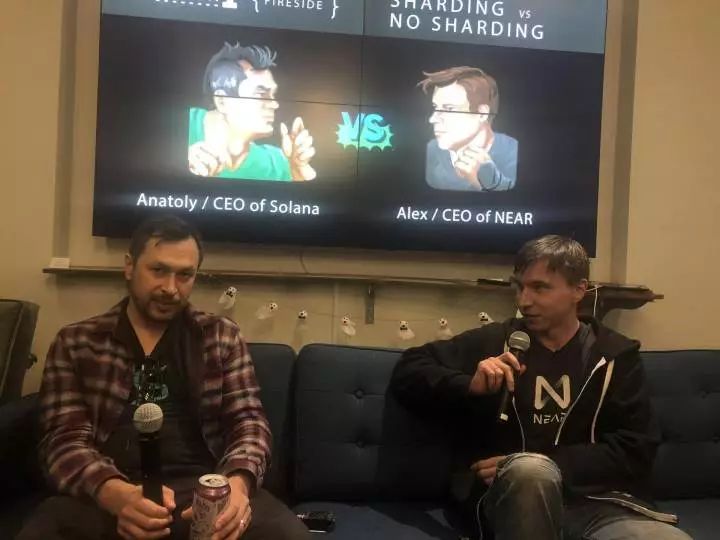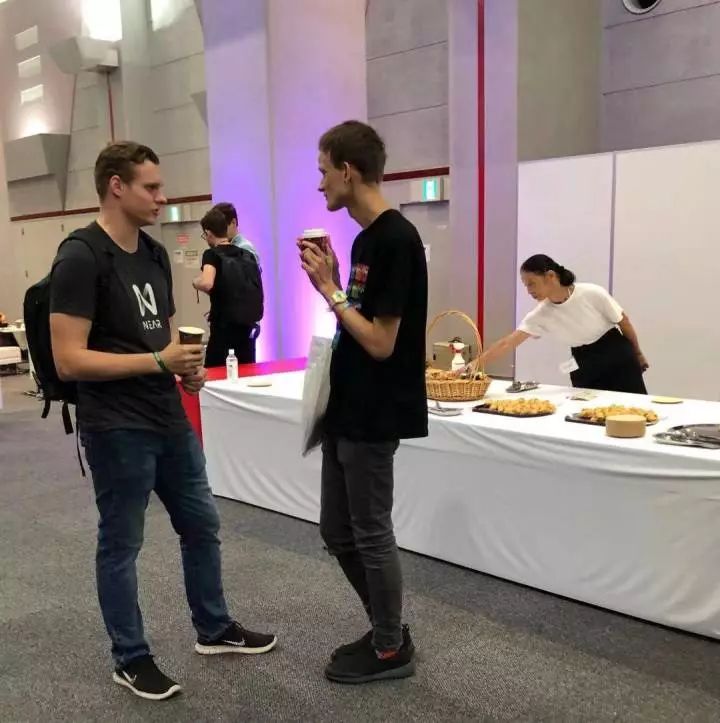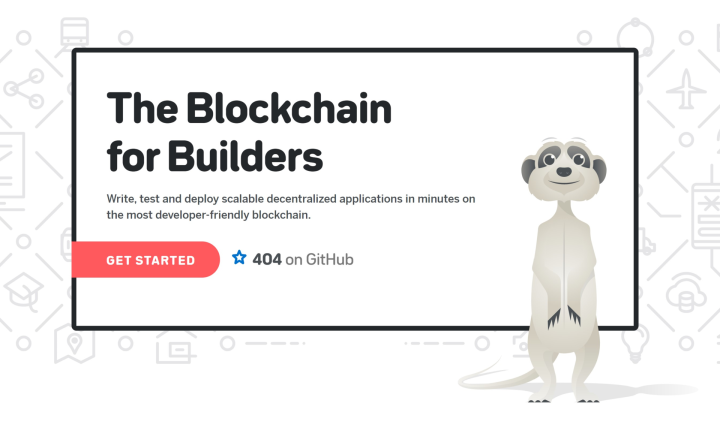Observation | The Last Public Chain: Who is the Last King?
Author: FYJ
Source: BlockBeats
Editor's Note: The original title was "The Last Public Chain"
This article records the story before and after my interview with the Near team in San Francisco, and describes the efforts of a group of "reliable" people to solve some "simple" problems in the industry.
- Discussion: The Future of Open Finance, Public Chain and Alliance Chain
- A man who knows cryptocurrencies better than Xiaozha forms the Blue Sky team and wants to "rule" decentralized social media standards
- Brand value on the chain, Nike blockchain anti-counterfeiting patents can still play like this?
Walking out of the Blockchain Week conference hall of the Four Seasons Hotel in San Francisco, I was a bit tired. Defi, privacy, stablecoin, these old-fashioned topics make it difficult for me to concentrate.
After a long afternoon sun in Union Square, I set off for the Near Protocol office two blocks away. The founder Illia will go to three panels tonight, but we have plenty of time for interviews.
Near entered the last sight of China's cryptocurrency a few months ago and announced that it had received a $ 12 million investment from several well-known crypto capitals, including Metastable and Multicoin. Coinciding with Illia's second trip to China, we were fortunate to meet each other in several public appearances, and even held an unsuccessful workshop for Near-no one knew what Near was at the time. Only a few people know that this is a sharding project from Silicon Valley, and the team is very good.
Located on the third floor of a joint space, the size of the Near office is small. The stone floor and several long tables make up the whole, without any work-related decoration. When I was standing in the middle of the room and no one looked up at me, Illia was explaining a task to a colleague.
Smelling the hot air in the computer room, Steve Jobs' garage and Ethereum's sea-view room suddenly appeared in my mind. After a while, I pulled myself back to reality, and then started to observe the people who were immersed in development.
In a sense, Near has gathered a bunch of the world's top software engineers today-they are famous Eastern European geeks in Silicon Valley. Illia is the main code contributor to Google's deep learning framework Tensorflow. The framework is famous for its Alpha Dog. Another founder, Alex, is the No. 1 employee of MemSQL. This fastest relational database today supports Uber daily Massive concurrency.
Elite supremacy computer teaching in Russia and Ukraine extends from the harsh system of the former Soviet Union, where algorithmic geniuses dominated the arena of ICPC competitions all year round.
At this time, there was a dozen world gold medals in the room.
Myths of protocol design
Today's cryptocurrency industry is basically pseudoscience.
——Meltem Demiors, former Managing Director of DCG
Illia has a side face similar to Vitalik, with a humble and gentle smile on her face. In the face of my problem, he used to talk about his perspective in a gentle tone, and occasionally gave me some demonstrations with a laptop that was not out of hand.
In mid-2017, Illia and Alex started their own business.The original idea of the two was to open up new ground in the field of AI.They tried to establish industry standards for Program Synthesis (blockBeats Note: a technology that can teach machines to write code). And use this to open up new markets. After nearly a year of exploration, they found that this technology, which has excited them since the college days, seems to be out of date. At that time, a large wave of "Ethereum killers" was making a noise, and the wave of encryption was sweeping through Silicon Valley.
"Someone suggested that we use Program Synthesis for smart contracts and formal verification to bring mathematical security to these codes," Illia told me:
"This is our opportunity to enter the blockchain, but then we have heard more and more developers complaining about the difficulty of developing blockchain applications, and we realize that many problems are still in their infancy."
Later, the two met with their longtime friend Evgeny, who has been engaged in blockchain research at Facebook for more than a year. They carefully disassembled and analyzed the technology and design of all Layer1 projects, and the prototype of the Near protocol gradually formed in the process.
Having glanced at the white chandelier in the conference room, I asked Illia an old-fashioned question: How are you going to beat Ethereum? Then I got an unexpected statement: we never thought of defeating them.
Cryptocurrency is a young world that is politically correct on a monthly basis. The most prominent groups, such as Bitcoin's biggest activists, Ethereum's biggest activists, and decentralized extremists, are always attacking and defending as the market moves. Recently, Ethereum has become the darling of the community again, and the evangelists seem to have a hundred kinds of arguments to support the view that "Ethereum is seriously underestimated." A few months ago, this group was still listing the guilt of Ethereum.
For some time, the impossible triangle of the public chain seemed to completely disappear. At that time, "Beyond Ethereum" was the industry standard. Times have changed. When Ethereum has become a mountain that many people can't cross, a few people begin to reflect on the myth of protocol design in the crypto industry.
Any area of blockchain consensus algorithm, cryptography and economic design is far from the public. This knowledge is often only in the minds of very few researchers who are far away from the public. The arrogant people often inadvertently commit terrible things. error. And few people understand these three directions at the same time-this makes the excess public chain technology into a foggy landscape without truth.
Sometimes changes introduced to solve one problem can lead to other problems in succession. The Chinese community of Ethereum 2.0 once had a message saying: "Many ways, the Ethereum community is not unexpected, but abandoned after discussion."
The first PoS-based BFT algorithm, Tendermint, took five years from conception to implementation; Solidity's zkSNARKs package was found to have serious vulnerabilities in August this year, and many Ethereum mixed currency projects that used this package were unaware of it; The Zyzzyva BFT system, which won the SOSP Best Paper in 2007, was found to be correct after ten years. Many protocols do not even have the opportunity to expose the problem compared to the errant ones, and they are left unattended because the value they carry is too low.
Early in the design of "Night Shadow", Illia and Alex had an in-depth discussion with Vitalik on the principles of Ethereum 2.0. They learned from the many protocols in the study of many agreements, and each time they exchanged with the core technical staff of different projects into a column video called "Whiteboard". From Solana to NuCypher, and then to AVA and Harmony, these videos reveal to the public the corner of the obscure second-generation public chain technology.

(Near and Solana co-hosted a "shard vs. non-shard" battle during Blockchain Week, pictured by Alex and Solana founder Anatoly)
It's hard for viewers to not re-evaluate whether the "security" of the crypto world really exists. With the advent of the PoS era, new technologies are coming one after the other, but it seems that there are not many people who really understand the mechanisms behind these agreements that support huge wealth. A considerable number of them are even dangerous attackers.
Kava CEO Brian Kerr has commented on Illia's "genius" for protocol design. Although cryptocurrencies are no longer popular, and Title is no longer the community's measure of project strength, I am sure that the person in front of me is one of the very few people in the world who can "essentially" understand the design of Ethereum 2.0. When Illia and Vitalik talked about the details of the sharding design at Devcon5, few people could understand their conversation.

(Illia and Vitalik at Devcon5)
After the Osaka party, Vitalik wrote and began to think about improving the efficiency of inter-chip communication by reducing the number of first shards for Ethereum 2.0. Alex later claimed that the design was very similar to Near's sharding solution, Night Shadow. But an important difference is that Near will set synchronous gas fees for different shards, while Ethereum chooses to hand over the coordination of gas costs to Layer 2.
Governance of Ethereum is known as "bazaar" development to describe some sort of disorderly prosperity of the open source community. But as the benefits of the "world computer" continue to expand, core developers have to start acting with caution. Instead, they proceeded cautiously after the new plan gained widespread trust from the community, rather than proceeding aggressively to avoid irrational blame for possible "mistakes." When a clear statement is required, Vitalik can only become the ultimate de facto leader of the community.
However, despite this outstanding leader, the great achievements of Ethereum are still dragging on the arrival of the new version.
"Near is good. It looks like a full version of Ethereum 2.0," a researcher from Berkeley told me in a chat. "But sharding is just one way to make the blockchain faster. It's a bit too complicated, I don't like it. "
"There are so many people in Silicon Valley doing blockchain. Everyone is familiar with it," Harmony founder Lan Rongjian revealed in an interview. "We have talked with Near. They think very carefully, but the engineering is very difficult. . "
As one of the earliest Chinese readers of the Near Technology White Paper "Night Shadows", I have long heard about the unique fragment design concepts in "Night Shadows" such as "blocking", "dynamic fragmentation", and "hidden validator". , Also aware of Illia and Alex's efforts to make the best trade-offs within the existing framework after extensive learning. But the status quo of star projects like Dfinity in the last round of bull markets made me equally wary of various high-end white papers.
"Near's technology is very good, but I don't think it's realistic, so we didn't continue to pay attention." An Asian crypto fund manager once told me that past project experience forced him to lower his expectations.
When I told Illia about this sentiment from the community, he just smiled and opened the core code library of "Night Shadow" in Github. After a brief review, I found that "Night Shadow" is actually nearing completion. In fact, at that time, Near's official website had begun to apply for an incentive test network called "Stake Wars".
At the same time, another founder, Alex, announced that he will try to partially use PoST in a future version of Near to solve the long-range attack problem (block rhythm BlockBeats Note: the most dangerous attack in PoS system), and write live on Twitch Finished the final tool for the mainnet version. According to Alex on social media, once the random source of the beacon chain is developed, there will be only testing work left before the mainnet launch.
"We are developing an Ethereum transition bridge, and Cosmos and Polkadot each have a team developing an Ethereum cross-chain bridge. We are the third one." When talking about coexisting with Ethereum, Illia said, "Of course, except for WASM, we will also support EVM, and the migration cost of the Ethereum ecosystem will not be too high. "
"If you lock Near in the contract, you can enter Ethereum and then use Maker indirectly." In Illia's talk about cross-chain technology, we ended the discussion of technology.

(A famous photo)
Not long ago, at a party in which Sequoia Capital Shen Nanpeng, Ceyuan Capital Feng Bo, Meituan Wang Xing and Bitmain Wu Jihan were all present, Vitalik was asked which rival made him feel pressure.
"Near is doing well," Vitalik replied.
Narrative and market
"People often compare the blockchain to the early Internet. The difference is that although there are bubbles in both, the number of early Internet users has grown rapidly."
——Dawn Song, Professor of Computer Science, University of California, Berkeley
While staying in Silicon Valley, I kept the habit of looking at the domestic community. At the end of October, shortly after the entire Political Bureau of the Communist Party of China learned about blockchain, the voice of the blockchain industry spread for the first time, and the entire crypto community was excited to finally talk with the mainstream.
In a short period of time, many people in the traditional industry have claimed that they are related to the blockchain and said "this is a new technology with unlimited potential."
"China has the world's largest Internet market, and people are very enthusiastic about blockchain. You know, when there are many users, the model will be different." Illia has always been curious about the Chinese market. During several exchanges in China, he found that China has a surprising number of consumers and developers in all areas of the Internet. But in the conversation, he also said: Near has no clear plan on how to enter the Chinese market. This is exactly the same as most Silicon Valley entrepreneurs and investors.
In the mobile era where the overall situation is still uncertain, Chinese entrepreneurs have pushed the consumer Internet to the top of the world, and the endless business models have made Silicon Valley's "hot money" curious and confused. But in China, speculative market policy signals have historically been difficult for Western capital without guidance.
"We just do everything we can to get the job done," Illia said. "Strong protocol, the best possible developer and user experience, and then wait for everything to happen."
Observing the Chinese market is more of a listening to the voice of the community for a Layer1 project. In fact, "a developer-friendly public chain" is the image that Near has always wanted to shape. Compared with many projects that subvert the world with pictures and slogans, Near's official website is pragmatic: the entry of "development documentation" and "online compiler" is placed in the most prominent position.

(Near's mascot stands aside)
"We want to attract developers." I have forgotten that this is the first time Illia has expressed this idea to me.
In the early days of Bitcoin, selfless crypto geeks led the community, and this deep and prudent group never fanned out before solving the problem. Nowadays, except for the widespread scammers, the blockchain industry is considered to be dominated by speculators and a few dreamers.
From "the greatest financial invention since double-entry bookkeeping", to "changing the production relations of human society", to "new paradigms of social governance", most crypto practitioners have an unstoppable momentum. But after the "grand narrative", there is only one place of "decentralization". Day after day, capital and people have already lowered expectations.
"Silicon Valley and Wall Street both say they take this thing seriously, but no one is a fool." A Silicon Valley investor told me privately. "Everyone is watching after the last wave of projects." In words, he could hardly conceal the dilemma of the industry.
"It was like a group of ordinary people who suddenly felt like a savior," he said. "In the end I couldn't make anything, I just wanted to get away."
Blockchain claims to be a technology that can serve the general public through "low access". But for a long time, many technical elites have been obsessed with creating utopias in the logical world, lacking the habit of talking with ordinary users.
"The main thing is to get more users," Illia said. "They don't need to know what the blockchain is. The protocol layer should be completely hidden from users. Everything else will be future."
In addition to a fool-style online smart contract IDE that is “click to open and use one-click chaining”, Near also independently developed a “fool-style” wallet: after the mobile phone is registered, it can directly transfer and authorize various Dapps.
Since this year, with the promotion of Vitalik, smart contract wallets represented by Argent have entered the public eye. This type of wallet uses smart contracts to create accounts for users, and implements third-party private key recovery through code logic, which greatly optimizes the security model of the key system.
Near proposes a "progressive security" design based on this: a centralized registration system provides the easiest on-hand experience, and users with both needs can easily create a local key pair and integrate it into their account.
At the same time, the local private keys of different devices with the same account can be cross-device authorized through a centralized server (Block Beats Note: similar to WeChat mobile version and web version), so the risk of private key transfer leakage is basically eliminated.
"20 models, there will be about 20 Dapps launched at the same time when the Near mainnet is launched." Although Near has always shown a hard-working spirit, the number 20 is still surprising. In fact, shortly after that conversation, the two projects in Near First State completed the seed round with the assistance of the team.
In addition to technology, the Near team also has nine serial entrepreneurs, so its mature business outlook is not common in the industry. Out of rationality, they chose to stand on the proven success model-complementing Ethereum.
Ethereum's Gas model is often criticized as full of loopholes, but some "deliberate subversion" of the latecomers are not ideal. The design of Near maintains the golden mean: In addition to the unified gas fee across the entire network and the dynamic sharding introduced to resolve single contract congestion, Near redesigned the price mechanism of Gas and incorporated storage into the fee range to address the ether Gas waste and state explosion on the square are urgent.
"App developers and wallets can sell services to users as monthly members," Illia said. "Or a free service and then monetize in-app conversions."
"Turning an application into a chain will raise the threshold for developers. For example, cross-chain is like an enterprise-level solution, and we are a cloud without a threshold." When it comes to the difference between sharding and cross-chain, Illia is still Be patient about emphasizing developer friendliness.
In subsequent conversations, we talked about Near setting up a non-profit foundation in Switzerland, and the development company will become part of the ecology; and the team's careful consideration of the public issue model that has not yet been decided.
When leaving, Illia hurriedly returned to work.
"Is there no scenario for the blockchain? It is not because the environment is not good, but the team in this industry is too crap."
A few months ago, the owner of a well-known cryptocurrency community bluntly.
Binance has become the industry's number one in just one year.Although there is no shortage of luck, it is generally considered by the community to be a "reliable" team.
Man proposes, God disposes. This is true of exchanges, and so is public chain.
Era of chaos
"The next hundred-fold return will be born in the application layer."
——Arthur, Arthur, Twitter Crypto KOL In people's minds, the West represents technology and China represents the market.
The development of the crypto industry is also in line with this law: the consensus, the progress of cryptography, and the concepts of Defi and DAO mostly come from the west, while the eastern market has formed its own set of methods in mining, trading platforms and wallets.
Following "9.4", "10.24" became the industry's second turning point due to the legitimization of the blockchain. In addition to the increasingly heated discussions on the prices of domestic projects by retail investors, the arrival of the regular army has also caused many blockchain practitioners to start rethinking the issue of landing.
From Libra's difficult advancement to the SEC's heavy blow, from MakerDAO's compliance differences to the oracle difficulties that are shaking the entire Defi field, to DCEP's high-profile appearance and active exploration of Hong Kong and trading platform supervision. All trends point to an end: As the only application of the blockchain to date, "programmable money" must and can only move toward compliance and regulation.
At the same time, after a series of technology pie sizzled by capital, the industry's attention to cutting-edge technologies is decreasing. In other words, attention to the many public chain and cryptography technologies that are staying at the concept stage is decreasing.
In the series of public chains that will be launched from the end of 2019 to the beginning of 2020, except for Ethereum 2.0, including Near, Cosmos, Polkadot, Conflux, Nervos, Filecoin and other Layer1 projects basically have strong technical capabilities and mature market awareness. .
However, with the continuous maturity of the second-generation public chain research, the protocol layer standard of the blockchain technology is expected to basically take shape in one to two years, and there is not much time left for all smart contract platforms: when excellent technology becomes a " "Standard configuration", how to become the birthplace of "Tianwang-level applications", has become a problem that all public chains really need to solve.
Not long ago, a16z Crypto led the Series A round of the decentralized lending agreement Compound, with a financing amount of $ 25 million. As early as last year, this established fund acquired 6% of MKR for $ 15 million and became an important maker of Maker.
Institutional winds and community sentiment quietly point to a new consensus: the next wave will be dominated by the application layer.
Near seems beyond reproach in protocol design. But it is obvious that what really sets it apart is a "radical" ecological strategy: the lowest development threshold, the most open and compatible standards, and the single-point support that goes all out.
After my trip to California, I returned to New York. One day, I read a memoir of an entrepreneur. The article tells the story of a group of college students exploring the fun of email interaction with crude technical conditions during the millennium years ago. After reading the article, I remembered that my engineer roommate had asked me: What can a blockchain do?
Often at this time, the scene will greet the sluggish eyes of others in my interpretation of "trust" and "immutable", and I will turn the topic elsewhere with interest.
After returning home that night, I opened the test wallet of Near's official website boredly and found a trick game called "Dog Dog" that I had previously ignored. After a few simple operations, I obtained a rare species called "thin tank" and stored it in my wallet.

"A dog that can be bought and sold freely and stored in a wallet."
Not a new experience. But at that moment, I suddenly felt that the blockchain was not so boring.
We will continue to update Blocking; if you have any questions or suggestions, please contact us!
Was this article helpful?
93 out of 132 found this helpful
Related articles
- New York Department of Financial Services (NYDFS) plans to update BitLicense terms for the first time in 5 years, currency exemption list + listing template
- AI analyzes 17-bit encrypted Big V personality: Vitalik is the most intelligent, and BM has strong self-confidence
- Leader of Tencent blockchain technology: Excellent blockchain application scenarios need to meet three dimensions
- Filecoin launches testnet today, mainnet will be online from March to April 2020
- Recruitment of blockchain talents returns to rationality: both the number of miners and the salary of mining-type companies have fallen
- Babbitt Original | Return to the Securities and Futures Commission 22 years later, why did Yao Qian ’s “return” attract much attention?
- Looking for his own coordinates in the long river of blockchain, Ling listened to the five major topics of the 2020 New Year's Eve speech for the first time





